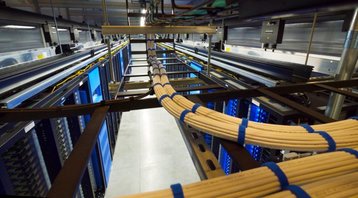I might be wrong but I have long regarded Facebook’s Open Compute Project (OCP) as sitting more in the silo of the ICT stack as in the M&E silo but increasingly I see the silo walls blurred. Usually I would argue that removing the three silos (ICT, electrical & mechanical) in the data centre is a very good thing, especially when it comes to minimizing energy consumption, but in the case of the electrical supply inside the cabinet I am not so sure.
Just last week Google announced that they were ‘joining’ the OCP community to share their experiences, particularly with regard to 48VDC power supply. In the press release, Urs Hölzle (Google’s global head of such matters) said ‘Google’s 48V rack specifications had increased its energy efficiency by 30 percent, through eliminating the multiple transformers usually deployed in a data center’. Now, to avoid misleading the general reader from running away with the idea that Google have saved 30 percent of their energy demand, we should translate the ‘30 percent improvement’ into something more like ‘reduced electrical distribution losses from 9 percent to 6 percent’ but the rest of the sentence is absolutely key to our understanding of the arguments in favour (or against) DC power in the data centre.
Keep 48VDC in the cabinet
Clearly no-one distributes 48VDC around a large data centre – the capital cost, voltage-drop, consumption of copper, weight and space all preclude such a low voltage in a bulk power system - so what is best is to distribute at a higher voltage to each cabinet and then rectify at the cabinet level. There is also little point pretending that that is the end of the voltage story because the server mother-board requires precision regulated 12V and/or 5V and then on-board DCDC converters take the voltage down to the chip level, e.g. 1.2V.
So, in North America, one way of saving energy is to avoid transformers by distributing 480V 4-wire and connecting each cabinet at 277V Ph-N. That is what they often do for lighting circuits where you don’t need plugs/sockets and switches which are limited to 250V in the current standards and that is one of the best options for rectifier choice in the OCP.
In Europe, changing to DC will save you nothing as you will have no transformers to remove
So how would the typical European data centre provision such a system if it was designed over here? Easy, we would take our 4-wire 400V supply to the cabinet row and probably choose a standard 230V phase-neutral single-phase connection to the ACDC rectifier. That 400V 3ph+N would come from the facility MV/LV transformer and would not involve any transformers – none in the UPS or in the PDUs. The point is that we (in 4-wire, 50Hz, Europe) don’t use ‘the multiple transformers usually deployed in a data center’ that Google refers to. I can’t remember the last time I saw a European UPS with an output transformer (>8 years?) and we have never needed PDU transformers. Our electrical distribution system can already achieve <3 percent losses between utility transformer and load, even with a VI UPS not using eco-mode.
The simple fact is that if you compare AC to DC cabinet supply systems you have to first of all ask ‘where are you?’
Europe does not have multiple transformers
If the answer is ‘in North America’ then changing to DC will save you energy as long as you remove all transformers (and that is more resisted than accepted in many situations). They could alternatively choose the European 400V 4-wire and achieve the same goal although it would be better to choose higher than 400V, but that is another story.
If the answer is ‘in Europe’ then changing to DC will save you nothing as you will have no transformers to remove. In fact you can argue that changing to DC means that you will always have to have A & B dual-bus systems operating at higher losses even if you don’t want concurrent maintainability but, again, that is another story.
It is worth noting here that the comments above apply considerably more if you decide to distribute 400VDC around the data centre – in fact any energy saving is negative in a European context.



